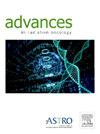高剂量率近距离放射治疗中2 Gy当量剂量对宫颈癌体外α/β比值变化的影响
IF 2.2
Q3 ONCOLOGY
引用次数: 0
摘要
目的探讨宫颈癌高剂量近距离放射治疗(HDR-BT)中2 Gy当量剂量(EQD2) α/β体外测量值的分布及其不确定度。方法与材料对31篇已发表的23株宫颈癌细胞系的98个α/β值进行分析。价值进一步分为鳞状细胞癌和腺癌组织学。使用自举Kolmogorov-Smirnov拟合优度检验将概率分布拟合到直方图。测定宫颈癌的平均α/β值和最可能α/β值。然后将概率分布应用于三种具有代表性的外束治疗(EBT)加HDR近距离治疗处方,以确定它们对每个处方的2 Gy当量剂量(EQD2)的潜在影响。结果α/β值在1.06 ~ 34.3 Gy之间。右斜对数正态分布被证明是总体α/β值以及鳞状细胞癌和腺癌亚型的最佳拟合。总癌组、鳞癌组和腺癌组的平均α/β值分别为8.05、8.47和6.60 Gy。最可能的值分别为4.25、4.34和4.22 Gy。α/β值的变化导致EQD2的不确定度为- 8.0 ~ 46.4 Gy。对于83.9 Gy的EQD2处方,平均α/β值导致EQD2偏差高达4.3 Gy,而最可能的值导致差异高达10 Gy。我们使用我们的α/β值分布来创建EQD2的不确定性分布,并发现EQD2中83.9 Gy处方与预期剂量的平均变化高达8%。结论体外α/β值变化较大,呈右偏对数正态分布,宫颈癌最可能值为~ 4.3 Gy。与鳞状细胞癌相比,腺癌的平均α/β值略低,但差异不足以得出明确的结论。与α/β值相比,较低的α/β值导致HDR-BT的EQD2升高。这表明更准确和可能更低的α/β值应该用于宫颈癌。本文章由计算机程序翻译,如有差异,请以英文原文为准。
In Vitro α/β Ratio Variations in Cervical Cancer, with Consequent Effects on Equivalent Dose in 2 Gy Fraction in High-Dose-Rate Brachytherapy
Purpose
To determine the distributions of published α/β values measured in vitro and the resulting uncertainties in the equivalent dose in 2 Gy fractions (EQD2) when applied to high-dose-rate brachytherapy (HDR-BT) for cervical cancer.
Methods and Materials
An analysis of 98 published α/β values from 31 papers was conducted, spanning 23 cervical cancer cell lines. Values were further divided into squamous cell carcinoma and adenocarcinoma histologies. Probability distributions were fit to histograms using the bootstrapped Kolmogorov-Smirnov goodness-of-fit test. Both average and most probable α/β values for cervical cancer were determined. The probability distributions were then applied to three representative external beam therapy (EBT) plus HDR brachytherapy prescriptions to determine the potential impact they would have on the equivalent dose in 2 Gy fractions (EQD2) for each prescription.
Results
Published results of α/β values ranged from 1.06 to 34.3 Gy. A right-skewed log-normal distribution was shown to be the best fit for overall α/β values as well as for squamous cell carcinoma and adenocarcinoma subtypes.. Average α/β values were determined to be 8.05, 8.47, and 6.60 Gy for the total, squamous cell carcinoma, and adenocarcinoma groups, respectively. The most probable values were 4.25, 4.34, and 4.22 Gy, respectively. The variations in α/β values led to uncertainties of −8.0 to 46.4 Gy in EQD2. Average α/β values resulted in EQD2 deviations of up to 4.3 Gy for the 83.9 Gy EQD2 prescription, whereas most probable values resulted in disparities as significant as 10 Gy. We used our α/β value distributions to create uncertainty distributions for EQD2 and discovered that the 83.9 Gy prescription in EQD2 had average variations of up to 8% from the intended dose.
Conclusion
There was large variation in in vitro α/β values which presented as a right-skewed log-normal distribution with a most probable value of ∼4.3 Gy for cervical cancer. Adenocarcinoma showed somewhat lower average α/β values compared with squamous cell carcinoma, but the difference was not substantial enough to draw definitive conclusions. Lower α/β values resulted in higher EQD2 for HDR-BT compared with α/β values at 10 Gy. This suggests that more accurate and potentially lower α/β values should be used for cervical cancer.
求助全文
通过发布文献求助,成功后即可免费获取论文全文。
去求助
来源期刊

Advances in Radiation Oncology
Medicine-Radiology, Nuclear Medicine and Imaging
CiteScore
4.60
自引率
4.30%
发文量
208
审稿时长
98 days
期刊介绍:
The purpose of Advances is to provide information for clinicians who use radiation therapy by publishing: Clinical trial reports and reanalyses. Basic science original reports. Manuscripts examining health services research, comparative and cost effectiveness research, and systematic reviews. Case reports documenting unusual problems and solutions. High quality multi and single institutional series, as well as other novel retrospective hypothesis generating series. Timely critical reviews on important topics in radiation oncology, such as side effects. Articles reporting the natural history of disease and patterns of failure, particularly as they relate to treatment volume delineation. Articles on safety and quality in radiation therapy. Essays on clinical experience. Articles on practice transformation in radiation oncology, in particular: Aspects of health policy that may impact the future practice of radiation oncology. How information technology, such as data analytics and systems innovations, will change radiation oncology practice. Articles on imaging as they relate to radiation therapy treatment.
 求助内容:
求助内容: 应助结果提醒方式:
应助结果提醒方式:


